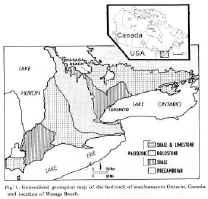|
Sedimentary Geology, 14
(1975), 169-190
SEDIMENTOLOGY OF A
LACUSTRINE BARRIER SYSTEM AT WASAGA BEACH, ONTARIO, CANADA
I.P. MARTINI
Department of Land Resource
Science, University of Guelph, Guelph, Ont. (Canada)
¡¡
 In an area of 4 by 15 miles
(6.5 X 24 km) at Wasaga Beach, Ontario, a Holocene system is exposed that can be
considered sedimentologically to be a lacustrine "barrier island
complex", although the initial features were formed as a spit-baymouth bar
combination. The sedimentary facies of the system are comprised of lagoonal or
bay deposits: calcareous, fossiliferous clays and silts interstratified with
sandy layers, some showing regular alternation and which originated as storm
layers; beaches of the barrier itself that range from older coarse
shingle-beaches to more recent sandy and locally fossiliferous ones. The beach
sediments show several cycles of deposition. A type of macrocyclicity is related
to coarsening-upward cycles in the pebble beaches, the coarser and higher layers
indicating strong storm conditions. Smaller cycles within the sections have
characteristic fining-upward sequences indicating different storm or
fair-weather conditions. Swash zones migrating during falling stages of storms
are well defined by typical openwork granule layers. Cycles of the sandy beaches
are characterized by erosional surfaces and alternation of plane beds and
ripple-drift cross-lamination. The whole barrier is capped by foredunes,
transverse and high parabolic dunes made up of very well sorted sands showing
regular to slightly modified large-scale cross-bedding. Unlike marine systems,
no intense bioturbation has occurred in these lacustrine units, the standlines
are well defined because of lack of significant Influences from tides, the
various subenvironments can be readily recognized, the approximate energy
conditions existent at the time of growth of the barrier can be reconstructed,
and sedimentological models can be built. A descriptive analogue model of the
lacustrine barrier system is presented. In an area of 4 by 15 miles
(6.5 X 24 km) at Wasaga Beach, Ontario, a Holocene system is exposed that can be
considered sedimentologically to be a lacustrine "barrier island
complex", although the initial features were formed as a spit-baymouth bar
combination. The sedimentary facies of the system are comprised of lagoonal or
bay deposits: calcareous, fossiliferous clays and silts interstratified with
sandy layers, some showing regular alternation and which originated as storm
layers; beaches of the barrier itself that range from older coarse
shingle-beaches to more recent sandy and locally fossiliferous ones. The beach
sediments show several cycles of deposition. A type of macrocyclicity is related
to coarsening-upward cycles in the pebble beaches, the coarser and higher layers
indicating strong storm conditions. Smaller cycles within the sections have
characteristic fining-upward sequences indicating different storm or
fair-weather conditions. Swash zones migrating during falling stages of storms
are well defined by typical openwork granule layers. Cycles of the sandy beaches
are characterized by erosional surfaces and alternation of plane beds and
ripple-drift cross-lamination. The whole barrier is capped by foredunes,
transverse and high parabolic dunes made up of very well sorted sands showing
regular to slightly modified large-scale cross-bedding. Unlike marine systems,
no intense bioturbation has occurred in these lacustrine units, the standlines
are well defined because of lack of significant Influences from tides, the
various subenvironments can be readily recognized, the approximate energy
conditions existent at the time of growth of the barrier can be reconstructed,
and sedimentological models can be built. A descriptive analogue model of the
lacustrine barrier system is presented.
|